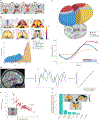The impact of the human thalamus on brain-wide information processing
- PMID: 37237103
- PMCID: PMC10970713
- DOI: 10.1038/s41583-023-00701-0
The impact of the human thalamus on brain-wide information processing
Abstract
The thalamus is a small, bilateral structure in the diencephalon that integrates signals from many areas of the CNS. This critical anatomical position allows the thalamus to influence whole-brain activity and adaptive behaviour. However, traditional research paradigms have struggled to attribute specific functions to the thalamus, and it has remained understudied in the human neuroimaging literature. Recent advances in analytical techniques and increased accessibility to large, high-quality data sets have brought forth a series of studies and findings that (re-)establish the thalamus as a core region of interest in human cognitive neuroscience, a field that otherwise remains cortico-centric. In this Perspective, we argue that using whole-brain neuroimaging approaches to investigate the thalamus and its interaction with the rest of the brain is key for understanding systems-level control of information processing. To this end, we highlight the role of the thalamus in shaping a range of functional signatures, including evoked activity, interregional connectivity, network topology and neuronal variability, both at rest and during the performance of cognitive tasks.
© 2023. Springer Nature Limited.
Figures




Similar articles
-
Contributions of the left and right thalami to language: A meta-analytic approach.Brain Struct Funct. 2024 Dec;229(9):2149-2166. doi: 10.1007/s00429-024-02795-3. Epub 2024 Apr 16. Brain Struct Funct. 2024. PMID: 38625556 Free PMC article.
-
Functional connectivity profile of the human inferior frontal junction: involvement in a cognitive control network.BMC Neurosci. 2012 Oct 3;13:119. doi: 10.1186/1471-2202-13-119. BMC Neurosci. 2012. PMID: 23033990 Free PMC article.
-
Exploring the brain network: a review on resting-state fMRI functional connectivity.Eur Neuropsychopharmacol. 2010 Aug;20(8):519-34. doi: 10.1016/j.euroneuro.2010.03.008. Epub 2010 May 14. Eur Neuropsychopharmacol. 2010. PMID: 20471808 Review.
-
Modeling the role of the thalamus in resting-state functional connectivity: Nature or structure.PLoS Comput Biol. 2023 Aug 3;19(8):e1011007. doi: 10.1371/journal.pcbi.1011007. eCollection 2023 Aug. PLoS Comput Biol. 2023. PMID: 37535694 Free PMC article.
-
The large-scale functional connectivity correlates of consciousness and arousal during the healthy and pathological human sleep cycle.Neuroimage. 2017 Oct 15;160:55-72. doi: 10.1016/j.neuroimage.2017.06.026. Epub 2017 Jun 12. Neuroimage. 2017. PMID: 28619656 Review.
Cited by
-
Local-structure-preservation and redundancy-removal-based feature selection method and its application to the identification of biomarkers for schizophrenia.Neuroimage. 2024 Oct 1;299:120839. doi: 10.1016/j.neuroimage.2024.120839. Epub 2024 Sep 7. Neuroimage. 2024. PMID: 39251116 Free PMC article.
-
Subcortical volumes and cognition in CADASIL - A pilot study.Cereb Circ Cogn Behav. 2024 Oct 9;7:100371. doi: 10.1016/j.cccb.2024.100371. eCollection 2024. Cereb Circ Cogn Behav. 2024. PMID: 39493517 Free PMC article.
-
The Impact of Bispectral Index Monitoring on Outcomes in Spinal Cord Stimulation for Chronic Disorders of Consciousness.Ther Clin Risk Manag. 2024 Sep 27;20:677-687. doi: 10.2147/TCRM.S478489. eCollection 2024. Ther Clin Risk Manag. 2024. PMID: 39355234 Free PMC article.
-
Thalamic Roles in Conscious Perception Revealed by Low-Intensity Focused Ultrasound Neuromodulation.bioRxiv [Preprint]. 2024 Oct 10:2024.10.07.617034. doi: 10.1101/2024.10.07.617034. bioRxiv. 2024. PMID: 39416133 Free PMC article. Preprint.
-
Subcortical contributions to the sense of body ownership.Brain. 2024 Feb 1;147(2):390-405. doi: 10.1093/brain/awad359. Brain. 2024. PMID: 37847057 Free PMC article.
References
Publication types
MeSH terms
Grants and funding
LinkOut - more resources
Full Text Sources
Medical

